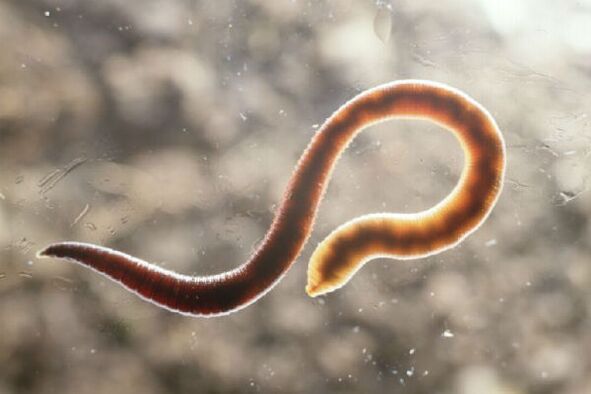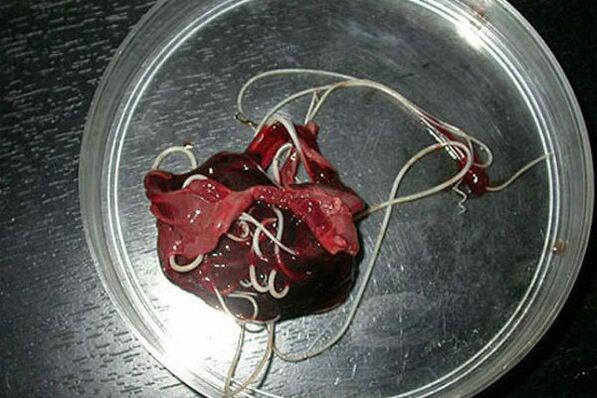
Worms in humans, the symptoms and treatment of which will be prompted by a doctor, in the human body are provoked by two types of worms - round (nematodes) and flat (flukes and tapeworms). Each parasite causes significant harm to the body, especially if appropriate treatment is not given in a timely manner.
Be sure to wash your hands when you get home, and also rinse vegetables or fruits under a stream of warm or hot water, as on it parasite eggs may be found. Products such as fish or beef must necessarily undergo heat treatment. Under the action of high temperatures, meat removes the eggs of various helminths, and can be suitable for consumption.
Varieties of ringworm
Pinworms are small gray-white parasitic flatworms that evoke enterobiasis.
Such parasites enter the human body in the following ways:
- food (through the oral cavity);
- through unwashed/dirty hands.
Cream worm eggs can be found in unwashed fruits or vegetables, or in the coats of sick animals. Children who scratch an itchy area of skin and then swallow an egg (e. g. , along with contaminated food) are more likely to be infected with enterobiasis. It takes two weeks to develop pinworm larvae in the environment of the gastrointestinal tract, and after full development, complete worms live in all parts of the large intestine.
Trichinella - this parasite has a round body no more than 5 mm long and stimulates trichinosis in the body. Larvae and eggs prefer to be in poorly fried meats (wild boar, pork, bear meat). In the human body, it takes up to 4 days for Trichinella to become an adult, and its life cycle is 40 days. The main purpose of this type of worm is to enter the bloodstream through the intestinal wall and settle in the muscles. In addition, the muscles of the respiratory and musculoskeletal systems are often affected.
Roundworms are representative of large size, have a spindle shape with a reddish-yellow color. Males of this species reach a size of 15-25 cm, and females - up to 40 cm Their bodies do not have any adaptation for fixation in the intestine, they simply move freely to the mass of food through the intestine.
You can be infected with ringworm by swallowing mature eggs when eating unwashed vegetables or fruits, where the smallest particles of soil remain. After the eggs enter the internal environment of the body, adult larvae hatch from them, invading the intestinal wall. Through the bloodstream, parasites can reach the heart muscle, and then to the lungs.

Only at this, the cycle of travel through the body does not end, as the larvae move through the respiratory tract into the mouth.
By re -ingesting the parasite, the body has created a good environment for its development.
The full worm passage will be located through the small intestine. Their life cycle is 12 months, after which they die and are excreted in feces.
Vlasoglavy - worms in humans, symptoms and treatment of which are determined at any time after infection, preferring to live directly in the intestine. These worms feed on blood components or feed on the intestinal mucosa.
Females lay eggs directly on the walls of the affected organs, then they come out along with the feces and thrive in environmental conditions. Mature larvae, whose bodies are oval, and do not exceed the limit of 5-15 mm. entering the human body in food.
This parasite has a round body no more than 5 millimeters long and stimulates trichinosis in the body. Larvae with eggs are found in poorly fried meats (wild boar, pork, bear meat).
In the human body, it takes a maximum of 4 days for Trichinella to become an adult, and its life cycle does not exceed 40 days. The main purpose of this type of worm is to enter the bloodstream through the intestinal wall and settle in the muscles. In addition, the muscles of the respiratory and musculoskeletal systems are often affected.
Necator/worm. The relationship between these parasites is direct, related to the disease they cause and the biological signs. They live in the duodenum, and because of their small size (10-15 mm) they move freely in its surroundings.
Larvae can enter the body only through the skin if a person has come in contact with contaminated soil. The next target of the worm is the lungs along with the gastrointestinal tract. They only eat the blood that comes out of the bitten blood vessel. As a result of the violent activity of this parasite, blood clotting is disrupted. Adults take blood in the range 0. 1-0. 35 ml per day.
Varieties of flatworms

Wide ribbon. The body length of the parasite, i. e. 10-20 meters, deserves attention.
Parasites come from freshwater fish and shrimp, the larvae enter the eggs and fill the fish.
The formation of adult worms takes a maximum of 25 days, and then a person becomes ill with diphyllobothriasis (disturbed digestive tract, vitamin B deficiency).
Liver fluke is a flattened worm, reaching a size of 10-20 mm, and there is a second name for this parasite - cat fluke. In 50% of cases of infection, residents who have eaten infected fish (carp, crucian carp, bream, roach) suffer. Fish are infected with liver worms through ingested snails that previously ate helminth eggs with fresh water.
To clean the fish from parasites, heat treatment is necessary, otherwise the larvae will enter the internal environment of the body, damaging the gallbladder with the intestines. Signs of the acute phase of the development of helminthiasis in humans are nausea, turning into vomiting, pain in the upper abdomen, allergic reactions, muscle cramps. Parasites create irreversible changes in the body, and even after expulsion from the patient’s body, all sorts of inflammation and disorders inevitably occur.
Pig / cow tapeworms. The body length of the parasite is 5-6 meters, and its larvae hide in the flesh of large animals (pork, beef). The diseases evoked by these helminths are called teniasis and teniarinhoz.
The larvae of both species of tapeworm, Finnish, are whitish vesicles attached to the wall of the small intestine. To reach and form an adult, the parasite takes 3 months, and every day the worm grows. The number of segments reaches 2000, the latter independently "shrinking" the large intestine.
Then the worm leaves the body along with the feces through the anus. The most common and obvious symptoms of helminthiasis are a disturbed digestive tract, as well as food intake in large amounts, and the patient does not visually gain weight.
Echinococcus. In this case, one acts as an intermediate host, because the latter are wolves, cats, dogs. Animals can be infected through direct contact with contaminated objects or people. As soon as the parasite eggs enter the intestine, larvae with six hooks immediately develop, which are called oncospheres in medicine.

The worm's favorite habitat is the lungs and liver, and the larvae become echinococcal cysts, increasing in size. All tissues adjacent to it are subject to rapid destruction.
Doctors often do not detect echinococcosis and confuse it with malignant or benign formation. In addition to squeezing blood vessels and internal organs, rupture of echinococcus cysts is common.
If this happens, not only does an immediate toxic shock occur in the body, but a ruptured cyst triggers the formation of several new ones.
The last type of parasite is alveococci, in the medical literature they are referred to as echinococci. It is these worms that evoke devastating diseases that cause harm corresponding to liver cancer and cirrhosis. The oncosphere of the worm enters the intestine, then the embryo hatches from the egg and begins to destroy the intestinal wall. After the wall is drilled, the parasite enters the bloodstream and spreads throughout the body.
Often, as noted earlier, alveococci invade the liver, where the larvae gradually grow. In the process of development, larvocysts are formed in worms - aggressive formations that increase rapidly in size (multi -chamber vesicles, gradually growing). These vesicles enter the liver cells, on the same principle as cancer metastases.
Nearby tissues feel a violation of blood flow, and then necrotic changes occur in them. Fibrous nodes with such multi -space blisters form on nearby structures, and they can stay in the human body for several years. That is why doctors, when detecting these parasites, use surgical intervention.
Note
Modern science knows about 280 species of worms. It is these microorganisms that can become parasites and grow in various tissues and organs of the human body.
Each year, these worms in humans, the symptoms and treatment of which are determined by doctors, affect the organs and tissues of about 15 million people, and most of them, more precisely, 80% of them are children.
How can you get worms:
- Consumption of meat dishes with poor heat treatment or raw meat in general. So, beef is the habitat of tapeworms, and pork carries pork tapeworms.
- Consumption of infected fish in salted or raw form. River water is often contaminated with helminth larvae.
- Water can also cause worms. This is due to the fact that one can drink raw water, or wash food, dishes with contaminated water. The risk is very high when outdoors.
- Soil can also cause the appearance of worms. Because it can contain animal or human feces. But how do worms get into the human body? The answer is simple - through unwashed hands after work in the garden or outdoor recreation.

In addition, you can be infected through direct contact with people who have helminthiasis. That is, the infection occurs through dishes, linens or personal hygiene items.
If the case is completely ignored and the parasitic infection is in the acute phase of its development, then the doctor prescribes detoxification and desensitization therapy. And if the disease is very severe, then glucocorticoids are prescribed.
Speaking for specific therapies, it takes into account the nature of the pathogen and involves special chemotherapeutic agents that are anthelmintic in nature.
In addition, patients are advised to take various antihistamines. At the end of treatment, you should take a course of probiotics. All this is needed to restore the intestinal microflora. In the process of treatment, patients must adhere to a special diet, which consists of easily digestible foods with a minimum fat content.
At the time of therapy, it is very important to adhere to perfect personal hygiene, otherwise there is a risk of re -infection.
In addition, all family members, as well as others who are in constant and close contact with the patient, should undergo anthelmintic treatment.
Signs of worms in humans: symptoms in children and adults
Signs of worms in humans, the symptoms of which may be similar, can be observed in a sharp form, both in adults and in children:
- Unreasonable increase in appetite and profuse saliva, and at the same time, weight loss rapidly.
- Another variant of symptom development may also occur - appetite disappears, after eating the person feels sick.
- Probably the appearance of headaches and dizziness.
- Loose stools or constipation may also indicate the presence of worms.
- Pain in the abdomen.
- Sudden onset of allergy symptoms are incomprehensible.
- Weakens hair and nails (its fragility increases due to lack of iron and vitamin B12).
- Due to a weakened immune system, various inflammations appear in the nasopharynx and in the genital area.
If the body is heavily infected with worms, large amounts of toxic substances that appear as a result of the vital activity of helminths are released into the human blood. This condition can affect a child's health. First of all, the nervous system suffers. Therefore, if a child shows sudden aggression, irritability, insomnia and other signs of nervous disorders, the child should be examined for the presence of helminths.

Although there are no obvious signs, and there are no functional disorders, worms can be present in the human body and need to take regular tests to identify them.
Often it happens that after preventive vaccination, a child experiences an allergic reaction due to the presence in the body of toxic substances secreted by helminths.
In fact, determining whether there are worms or not based on superficial signs alone is a rather difficult task. After all, the symptoms shown may be a sign of another illness. This task is very difficult for pregnant women. Because of all the above signs of worms in humans, the symptoms described above, in pregnant women appear due to the process itself.
For this reason, the signs of helminthic infections in pregnant women can be distinguished by symptoms such as: itching in the anus and burning in the vaginal area, which increases at night, weight loss, fatigue, fever.
To diagnose a helminth infection, several steps are performed, including the following procedures:
- Collect anamnesis to identify possible sources of infection.
- Study of fecal and blood samples, rectal and perianal mucus, muscle tissue, sputum and bile in the laboratory. When carrying out this activity, signs of the presence of helminths in the body (the egg or worm itself, as well as its parts) can be detected. It should also be noted that an increase in the number of eosinophils can serve as a sign of the presence of worms in the body.
- Serological studies (ELISA, RSK, etc. ) make it possible to detect the presence of parasites in the larval stage or helminths living in muscle tissue.
- To determine the presence of parasites affecting the liver, ultrasound, CT, and endoscopy were prescribed.
Worms in the human liver: symptoms according to the type of worm
Worms in the human liver, the symptoms of which largely depend on the type of helminths, can also migrate to other organs.
The appearance of the main signs of infection with worms does not appear immediately. In many ways, the timing of the appearance of distinctive features depends on the composition of the parasite species. So the presence of ascaris in almost two to three days is indicated by a deterioration in a person’s general condition.
The first symptoms of infection with other types of helminths in most cases begin to appear only two to three weeks after the end of the incubation period. There are such parasites (e. g. , filariasis) where the incubation period exceeds the six -month mark.
The problem of determining the presence of helminths in the human body is that in the case of a primary infection with a small number of worms or a single individual, there are almost no visual signs. Symptoms begin to appear only after intensive breeding of helminths or when they reach a large size (tapeworms, tapeworms).
It is most reliable to determine infection with pinworms. In front of them, characteristic itching appears in the anus, which increases at night. Basically, the itching occurs in a few days, then subsides for about two weeks and resumes.
When infected with helminths such as trichuriasis, ankylostomidosis, schistosomiasis, diphyllobothriasis, beriberi and anemia develop.
The onset of symptoms of infection with tapeworms largely depends on the period of development of the parasite. Therefore, if they are in the early stages of development, the larvae move through the blood to almost all internal organs and the following symptoms of the disease appear: subfebrile temperature, weakness, cough with purulent sputum, erratic infiltrates can be seen on x-rays. lungs, which then disappear.
With severe infection, bronchitis and pneumonia can develop. With the further development of the parasite, there is a violation of the function of the gastrointestinal tract.
Trichinosis - mainly indicates its presence with pain in muscle tissue, fever and swelling.
Such worms in the human liver, the symptoms of which are manifested by the icy skin, such as fascioliasis, opisthorchiasis, clonorchiasis, reveal its presence with an increase in the spleen and liver and other serious disorders of the body.
Almost all types of worms cause disorders of the central nervous system, while sick people feel severe headaches and fatigue, people who are generally calm become irritable and impatient, and unreasonable aggression attacks may appear.






































